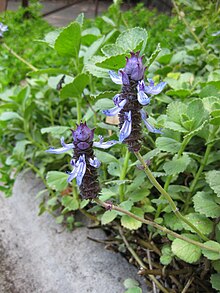Coleus neochilus
| Mosquito bush | |
|---|---|

| |
| Scientific classification | |
| Kingdom: | Plantae |
| Clade: | Tracheophytes |
| Clade: | Angiosperms |
| Clade: | Eudicots |
| Clade: | Asterids |
| Order: | Lamiales |
| Family: | Lamiaceae |
| Genus: | Coleus |
| Species: | C. neochilus
|
| Binomial name | |
| Coleus neochilus (Schltr.) Codd
| |
| Synonyms[1] | |
| |
Coleus neochilus, synonym Plectranthus neochilus,[1] which is colloquially known as lobster bush, fly bush or mosquito bush, is a perennial ground cover with highly fragrant, partially scalloped, ovate leaves and purple blue inflorescent spikes.[2]
Description
[edit]The succulent, grey-green leaves present with small hairs on the tops, and a grey-green colour. The plant itself remains a ground cover for the duration of its life (45–60 cm), forming massive bushes rather quickly. The aroma of the plant has been said to resemble cannabis or skunk.[3][4] They bloom twice a year, in late summer and in late winter.[5]
The specific epithet neochilus is derived from the Latin word chilo, which refers to the calyx or lips.[6]
Habitat
[edit]The plant is found in dry brush lands, open and sometimes rocky woodland, from the Western Cape, Eastern Cape, KwaZulu-Natal, Mpumalanga to Limpopo in South Africa, as well as in Zimbabwe, Zambia and Namibia.[7]
Cultivation
[edit]Lobster bushes can tolerate wide temperature ranges, dry conditions and almost any soil, but prefer a well-drained sandy loam in full sun or partial shade. Hard pruning is suggested after flowering. Stems root very readily and the plant extends, where it forms a tidy cluster. Often planted in the landscape of difficult areas, the plant may become a little stressed in very dry conditions, but would revive when it receives some water.
They can easily be propagated from softwood cuttings and would multiply in the garden. They are rarely affected by pests.[8]
Uses
[edit]It is said that this plant can repel snakes, mosquitoes, flies and most garden pests as a result of its fragrant nature. This makes Coleus neochilus an ideal companion plant for vegetable gardens. Furthermore, reports point out that these plants can be used efficaciously as an air purifier.[9]
The dried herb, known as "Falso Boldo" or "boldo-gambá", is employed for treating hepatic insufficiency and dyspepsia in folk medicine.[10]
Tea made by steeping fresh leaves is similar to mint tea.[11]
Gallery
[edit]-
Shrub at the Botanic Gardens in Sydney
-
Close-up of foliage in Pretoria, South Africa
-
Flowering at Huntington Gardens, Los Angeles
-
Close-up of an inflorescence
-
Flowers at Kirstenbosch Botanical Garden
References
[edit]- ^ a b Paton, Alan J.; Mwanyambo, Montfort; Govaerts, Rafaël H.A.; Smitha, Kokkaraniyil; Suddee, Somran; Phillipson, Peter B.; Wilson, Trevor C.; Forster, Paul I. & Culham, Alastair (2019). "Nomenclatural changes in Coleus and Plectranthus (Lamiaceae): a tale of more than two genera". PhytoKeys (129): 1–158. doi:10.3897/phytokeys.129.34988. PMC 6717120. PMID 31523157.
- ^ Codd, L.E. 1975. Plectranthus (Labiatae) and allied genera in southern Africa. Bothalia 11: 371-442.
- ^ Lland, Rae (June 20, 2018). "A Bud by Any Other Name: Check Out the Israeli Flower That Smells Like Weed". Leafly.
- ^ Feix, David (25 February 2002). "Re: Society Garlic". hort.net.
- ^ Plectranthus neochilus by Plant Lust
- ^ Hankey, A, Joffe, P. & Turner, S. 1999. Water-wise gardening for summer rainfall regions. National Botanical Institute and the Department of Water Affairs and Forestry, Pretoria.
- ^ Van Jaarsveld, E. 1997. Veld gardening in South Africa: the Valley Bushveld/Noorsveld. Veld & Flora 83: 20-25.
- ^ Van Jaarsveld, E. 1987. The Plectranthus handbook. National Botanic Gardens, Kirstenbosch.
- ^ Van Jaarsveld, E. 1997. Veld gardening in South Africa: the forest garden. Veld & Flora 83: 51-53. Tovhowani Mukoma Lowveld NBG, June 2004
- ^ Duarte, Márcia do Rocio; Lopes, Juliano Ferreira (December 4, 2007). "Stem and leaf anatomy of Plectranthus neochilus Schltr., Lamiaceae". Revista Brasileira de Farmacognosia. 17: 549–556. doi:10.1590/S0102-695X2007000400013 – via SciELO.
- ^ Pooley, E. 1998. A field guide to wild flowers of KwaZulu-Natal and the eastern region. Natal Floral Publications Trust, Durban.





